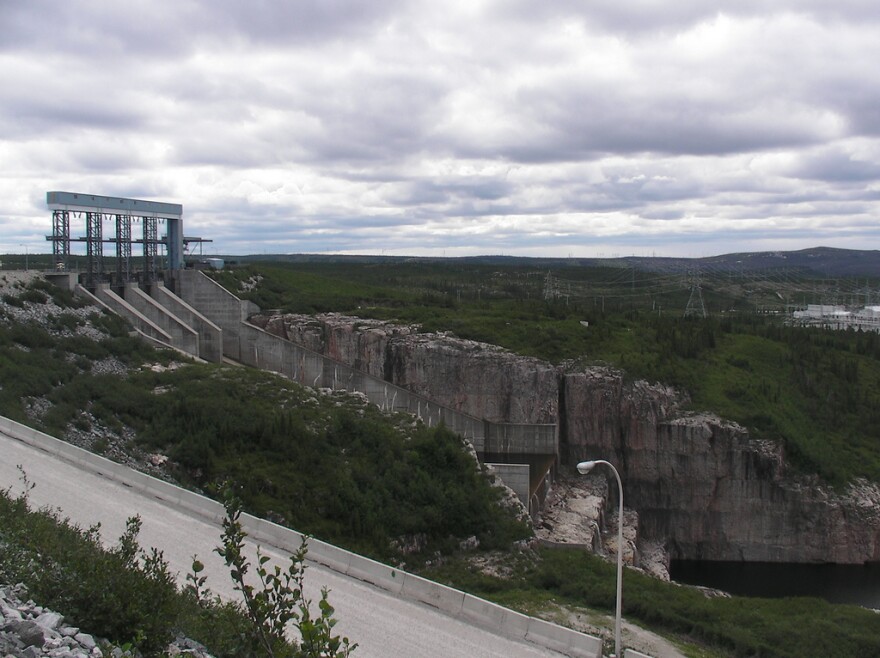Along the corridor of towns that would host the controversial Northern Pass Transmission line, it’s hard to find much support for the project.
But with power plants retiring and the slow growth of many renewables, all of those rivers in Canada look mighty promising to grid operators. As part of our weeklong series on NH’s energy future we ask does big Canadian hydro have a place in New England’s energy mix?
To start, let’s just put Northern Pass controversies aside: imagine all of the energy lines will be buried, or somehow the electricity will plug into the New England grid without wires.
If somehow that were the case, would Canadian hydro-power be a good idea then?
Big Hydro, Big Impacts
Ken Kimball says no.
He’s director of research for the Appalachian Mountain Club, and a board member for the New England based Low Impact Hydro Institute.
“Hydro-Quebec’s facilities are actually some of the largest re-plumbing of river ecosystems in the world. Of the larger reservoirs, those dams actually flood an area that represents about 80 percent of the area of New Hampshire.” Kimball explains, “So, low-impact, these projects are not.”
To get a lot of power power from rivers, involves flooding a lot of land, and in Quebec, they’ve done it by taking whole rivers and redirecting them into the reservoirs that feed their dams. These reservoirs cover plant-life. As those plants die and break down carbon dioxide is released into the atmosphere, and mercury is released into the water for decades after.

But while reservoir hydro is not a zero emissions energy source, it is still relatively low carbon says Hydro-Quebec spokesman Gary Sutherland citing “the hydro-electricity that’s generated here in Quebec, in 2010 it was about 30% of all the electricity generated in Canada, but it represented only 1% of the greenhouse gas emissions.”
This is partly because Hydro-Quebec doesn't only have reservoirs, but 38 percent of its power comes from run-of-river hydro, which entails much less flooding.
And from the perspective of the grid’s operators, hydro power plants that store water in big reservoirs have other advantages.
The Case For Big Hydro
For one they generate a lot of juice: Hydro-Quebec’s dams generate more than 33,000 megawatts of electricity: more than enough to power all of New England.
And that’s very appealing to folks like Michael Hogan, a consultant with the Regulatory Assistance Project which advises public officials on how to get carbon out of the electric supply.
“Without taking a position on Northern Pass as it’s currently configured,” he says, “the idea of building new transmission between Quebec and New England is a very good idea.”
Hogan points out that big hydro may have big impacts, but unlike other renewables, the floodgates can be opened whenever electricity is needed. And dams don’t take ten hours to warm up, so they can be brought online quickly, when other renewables start to fade, unlike some traditional fossil fuel or nuclear plants.
“Hydro and wind work together really well,” says Hogan, “I mean, you want to know how Denmark gets 20 percent on an annual basis, and sometimes more than 70 or 80 percent of its electricity from wind and still keeps the lights on, it’s because it’s connected to a hydro system in Norway that is basically the size of the Danish grid.”
Another Way?
But the environmental impacts of big hydro still worry people like Ken Kimball of the Low-Impact Hydro Institute. However, he does believe that smaller dams can have a place in New England’s grid.
“For example right now Boston gets it water from the Quabbin Reservoir system, and you could put turbines in that. A few megawatts here and a few megawatts there actually start to add up.”
Small scale and “run of river” hydro installations do exist in New England. There are three certified low impact installations in New Hampshire. That includes the fifteen mile falls dam on the Connecticut river; that’s a dam that generates roughly the same amount of power as a fossil fuel plant.
Kimball met me in front of a small one in Penacook. Power from these installations flows into the regional grid, just like other power plants, but they do so in a way that allows fish to pass by, and have minimal

impacts on the shoreline.
The biggest problem with small solutions like those Kimball proposes, is they are still tiny in the scheme of things. Consider that there are about fifty dams in New Hampshire, and taken together they account for about half the power of a modern natural gas power plant. It would take easily hundreds of the small turbines Kimball is talking about to have a real impact.
Hydro-Quebec Building Up to Push South
Meanwhile, Hydro-Quebec is itching to move its excess power south.
About 2,200 megawatts of Canadian hydro-power is already powering the New England grid, most of it flowing on a transmission line that reaches New Hampshire passing through Vermont. Hydro-Quebec sells retail power in Quebec at artificially low prices, by provincial law, which Kimball says makes the New England export market very attractive.
“As long as they can continue to sell this, they are going to build more dams and flood considerably more areas as they move forward, that’s their incentive.”
Whether or not Northern Pass becomes reality, Hydro-Quebec spokesman Gary Sutherland says they’ll continue to look for ways to build more interconnections with New England.
“HydroQuebec’s got a good product.” He opines, “We do have the resources for export, it’s a commercial relationship that’s been in place now for quite some time, and I see no reason that it wouldn’t continue to function and expand in the future.”
So whether it passes through New Hampshire or not, more big Hydro – and its big impacts – could wind up powering the Granite state.
There are those who believe that we can get our power without the big impacts of big installations. That’s the topic for tomorrow: flattening the peaks in the demand curve








